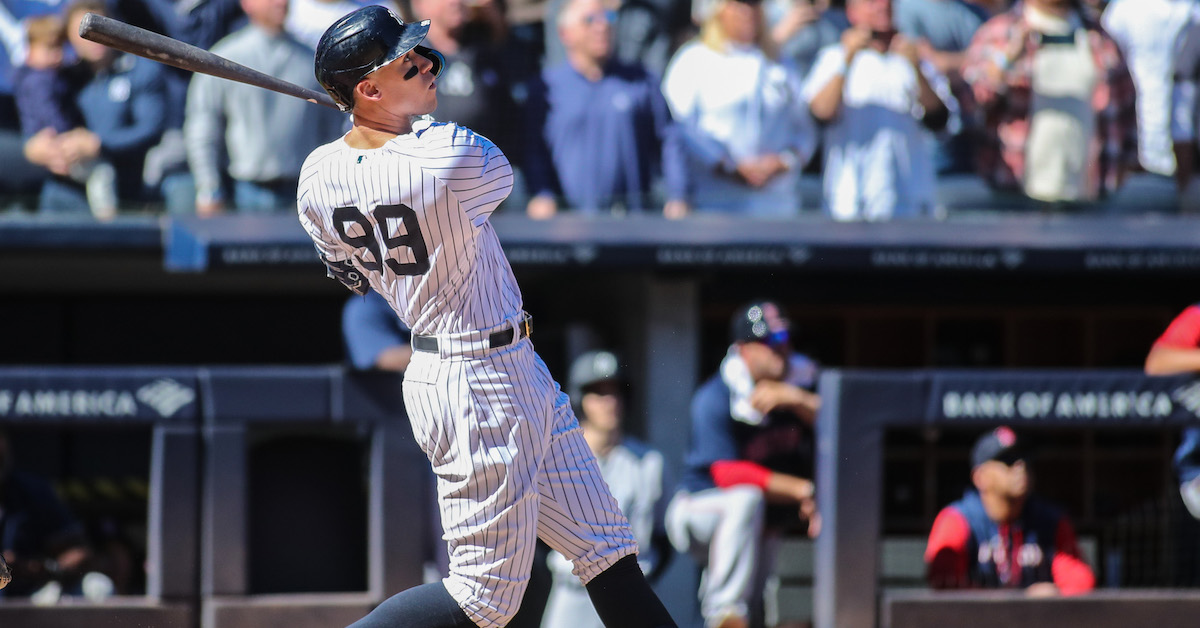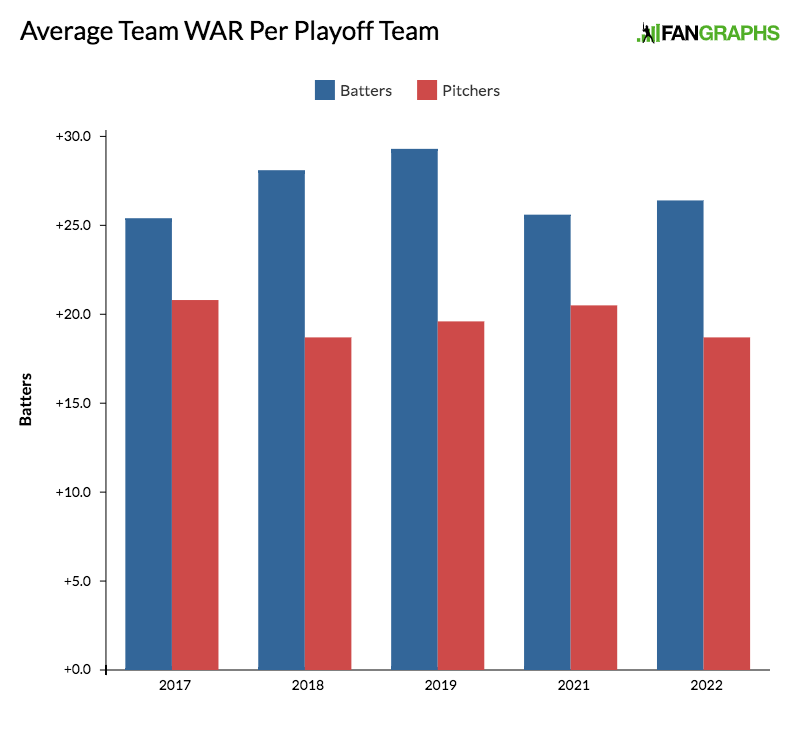Baseball’s Best Bats Are Headed to the Postseason

Mike Trout has as many MVP awards (three) as he has career playoff games, a fact that can haunt those of us who long to see generational stars get their chances in the brightest spotlights. It is an unfortunate side effect of the otherwise redeemable fact that in baseball, somewhat uniquely, no individual player has so much of an impact on his team’s performance as to secure them a playoff spot. Even the combination of Trout and fellow MVP Shohei Ohtani hasn’t been enough to nab the Angels so much as a Wild Card since 2014, instead playing out as a sort of macro Tungsten Arm O’Doyle scenario.
This year, Trout and Ohtani will once again be watching from home, the Angels having guaranteed a seventh straight season under .500. But them aside, the 2022 postseason is poised to be what it has failed to be in seasons past: a true showcase of the league’s finest offensive talent.
As it stood Wednesday, each of the league’s top 13 hitters by WAR are headed for postseason play, an entirely unprecedented level of October-bound talent at the top of the league. Led by Aaron Judge’s historic 10.9 WAR and a slew of NL MVP contenders, the top 13 represent nine of the 12 playoff teams, including each division winner. In fact, if the season ended today, 21 of the top 23 offensive players by WAR — all but Boston’s Xander Bogaerts and Trout, who, to be fair, both could have found themselves in the top 13 were it not for injuries — would qualify.
| Name | Team | WAR | HR | AVG | OBP | SLG | |
|---|---|---|---|---|---|---|---|
| 1 | Aaron Judge | NYY | 10.9 | 60 | .314 | .425 | .693 |
| 2 | Nolan Arenado | STL | 7.1 | 30 | .293 | .359 | .537 |
| 3 | Paul Goldschmidt | STL | 7.1 | 35 | .318 | .404 | .585 |
| 4 | Manny Machado | SDP | 7.0 | 31 | .296 | .367 | .532 |
| 5 | Freddie Freeman | LAD | 6.8 | 20 | .327 | .407 | .515 |
| 6 | Francisco Lindor | NYM | 6.8 | 25 | .275 | .346 | .456 |
| 7 | Jose Altuve | HOU | 6.3 | 28 | .298 | .387 | .531 |
| 8 | Yordan Alvarez | HOU | 6.3 | 37 | .304 | .407 | .614 |
| 9 | Mookie Betts | LAD | 6.2 | 35 | .267 | .339 | .535 |
| 10 | J.T. Realmuto | PHI | 6.2 | 21 | .277 | .345 | .480 |
| 11 | Trea Turner | LAD | 6.0 | 20 | .302 | .347 | .474 |
| 12 | Andrés Giménez | CLE | 6.0 | 17 | .305 | .377 | .484 |
| 13 | Dansby Swanson | ATL | 6.0 | 22 | .278 | .330 | .439 |
| 14 | Xander Bogaerts | BOS | 5.8 | 14 | .310 | .380 | .459 |
| 15 | José Ramírez | CLE | 5.8 | 28 | .277 | .354 | .515 |
| 16 | Alex Bregman | HOU | 5.5 | 22 | .263 | .370 | .462 |
| 17 | Austin Riley | ATL | 5.4 | 37 | .276 | .350 | .534 |
| 18 | Tommy Edman | STL | 5.4 | 13 | .262 | .321 | .398 |
| 19 | Mike Trout | LAA | 5.4 | 37 | .275 | .361 | .613 |
| 20 | Jeff McNeil | NYM | 5.1 | 7 | .319 | .375 | .439 |
| 21 | Julio Rodríguez | SEA | 5.0 | 27 | .280 | .342 | .502 |
| 22 | Michael Harris II | ATL | 4.9 | 19 | .306 | .346 | .536 |
| 23 | Brandon Nimmo | NYM | 4.9 | 14 | .268 | .362 | .418 |
No postseason has ever featured the majors’ top 10 hitters by WAR. The closest we’ve come was in 1999, when nine of the top 10 — missing only ninth-ranked Pirates outfielder Brian Giles — reached October. It represents a dramatic shift from last season, when just one of the top six hitters and three of the top 10 made the playoffs. Notably absent were both league’s leaders in WAR, Fernando Tatis Jr. (7.2) and José Ramírez (6.5), and AL and NL MVPs-to-be Ohtani (who ranked 20th in offensive WAR) and Bryce Harper.
It stands to reason that there would be more top hitters in the playoffs when there will be more players in the playoffs, now that we’re in the first season of the 12-team expanded format. But a closer look reveals that by any format, this would be an historic concentration of offensive talent. Just one of those top 13 hitters, 10th-ranked Realmuto, plays for a team that would not have qualified under last year’s format. Indeed, 15 of the top 23 play for teams that have clinched their division or are leading it. And although comparing the results of one season to one other, especially one as wacky as 2020, is only so useful, that year’s playoffs included 16 teams yet only seven of the top 10 players by offensive WAR.
In other words, playoff format aside, this season’s elite offensive performers seem uniquely concentrated among the best teams. As long as you’re not a pitcher on a playoff team, this is great news.
Speaking of, the phenomenon does not hold up on the pitching side, where four of the top 10 pitchers by WAR — Cy Young candidates Carlos Rodón, Sandy Alcantara, Ohtani, and Dylan Cease — will be absent in October, as well as others near the top of their craft like Zac Gallen, Logan Webb, and (potentially) Corbin Burnes. That still leaves plenty of talent staffing playoff rotations, but the top performers on the mound do appear to be more distributed across World Series hopefuls and noncontenders.
| Name | Team | WAR | ERA | FIP | xFIP | |
|---|---|---|---|---|---|---|
| 1 | Carlos Rodon | SFG | 5.8 | 2.98 | 2.35 | 2.98 |
| 2 | Aaron Nola | PHI | 5.8 | 3.28 | 2.65 | 2.84 |
| 3 | Kevin Gausman | TOR | 5.5 | 3.30 | 2.42 | 2.78 |
| 4 | Justin Verlander | HOU | 5.4 | 1.82 | 2.62 | 3.30 |
| 5 | Sandy Alcantara | MIA | 5.3 | 2.32 | 3.06 | 3.34 |
| 6 | Shohei Ohtani | LAA | 5.0 | 2.47 | 2.52 | 2.73 |
| 7 | Spencer Strider | ATL | 4.9 | 2.67 | 1.83 | 2.31 |
| 8 | Max Fried | ATL | 4.8 | 2.50 | 2.73 | 3.10 |
| 9 | Shane Bieber | CLE | 4.8 | 2.91 | 2.89 | 2.98 |
| 10 | Dylan Cease | CHW | 4.6 | 2.06 | 2.95 | 3.44 |
Does this suggest we might be in store for an unusually offensive postseason? There’s no perfect way to answer that question, but we can look at team WAR to try to evaluate the overall level of hitting and pitching talent headed to the playoffs. As it stands, in 2022, the average playoff-bound team has 26.4 batting WAR and 18.7 pitching WAR, meaning that hitters hold a 58.6% share of the total WAR on those teams. This is an increase from last year’s 55.4%, but a tick down from 2018 (60.1%) and ’19 (59.9%), suggesting that there isn’t an outlying historical imbalance in favor of offense overall this year, despite the presence of top talent.

In the coming month, baseball fans will once again miss Trout and Ohtani, a pair of singular talents who we should all hope to see in future postseasons. But this October, we can expect some serious star power in the batter’s box in one of the brightest showcases of what the league has to offer.
Chris is a data journalist and FanGraphs contributor. Prior to his career in journalism, he worked in baseball media relations for the Chicago Cubs and Boston Red Sox.

Interesting question (to me at least): Aaron Judge is currently sitting at 11.0 fWAR; the second-highest player in fWAR on the Yankees is Jose Trevino at 3.4. Has there ever been a bigger gap between a team’s best player and it’s second-best player in major league history?
Babe Ruth’s 1923 total (15.0) topped teammate Aaron Ward (4.4) by a ludicrous margin. More recently, Mike Trout’s 2013 (10.2) bested Hank Conger (2.7 in 92 games) by a similar margin.
I was just going to mention Conger! Interesting that in both recent cases it’s a center fielder and a catcher.
CJ Wilson actually was second on that 2013 Angels team with 2.9 fWAR, back when he could kinda-sorta pitch.
Looking it up, looks like the leaders in this category since 1901 are:
Babe Ruth, 1923: 10.6 over Aaron Ward
Rogers Hornsby, 1924: 9.2 over Ray Blades
Babe Ruth, 1921: 8.7 over Waite Hoyt
Babe Ruth, 1920: 8.4 over Del Pratt
Steve Carlton, 1972: 8.4 over Wayne Twitchell
Babe Ruth, 1924: 8.0 over Herb Pennock
Aaron Judge, 2022: 7.6 over Jose Trevino
Mike Trout, 2013: 7.3 over CJ Wilson
So the only people ahead of Judge on this list are Babe Ruth putting up the greatest seasons of all time while playing on Yankee teams that hadn’t yet picked up Lou Gehrig; prime Rogers Hornsby on a 65-89 Cardinals team; and Steve Carlton’s legendary 27-10 season for the 59-97 Phillies. Even Mike Trout can’t match him. Heady company.
Also looking this up made me realize that there is a HUGE disconnect between Tris Speaker’s defensive reputation and what the stats show for him. Speaker’s reputation as a defender was the clearcut best defensive outfielder in history before Willie Mays; his numbers are… mediocre, kinda good but nothing special. Speaker was known to play a very shallow CF; maybe the numbers are showing something in XBH that his reputation didn’t?
Aaron Judge is having the best non-steroid season for a position player since Mickey Mantle in 1956-1957. He’s behind Yastrzemski now, but he’ll almost certainly pass him. There’s an outside shot he could even pass Mantle in one or both of those years too.
I don’t think any of us, myself included, are able to wrap our brains around how crazy that is.
Just throwing this out there:
Career fWAR/650PA, 1947-present, minimum 35 career fWAR:
Mike Trout: 8.6
Barry Bonds: 8.5
Ted Williams: 8.2
Willie Mays: 7.8
Aaron Judge: 7.5
Mickey Mantle: 7.4
Mike Schmidt: 6.9
Buster Posey: 6.7 (I do not trust this number)
Hank Aaron: 6.4
Mookie Betts: 6.4
Jackie Robinson: 6.4
Eddie Mathews: 6.2
Alex Rodriguez: 6.1
What is it if you just look at ages 24-30 or something like that? The decline years might be throwing that off.
Trevino is interesting. He’s been worth -4.8 offensive runs and 26.8 defensive runs (most in MLB) en route to his 3.4 WAR. The Yankees lead MLB with 30.0 defensive runs as a team.
Jonathan Schoop is second with 22.2 defensive runs, but Detroit as a whole is at -22.2 defensive runs.
I guess what I’m saying is that defensive measurements are still really strange to me, and I’d love a deep dive into where these guys are getting such extreme numbers.